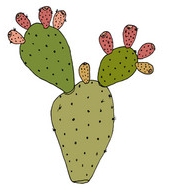

This hybrid is low growing, and produces very nice, dark pink flowers.
This hybrid comes from Michael Kießling.
Flowers fade from yellow to orange, but various from year to year.
This German hybrid has lovely pink flowers.
Flowers readily, and stays low, but will spread.
This German hybrid has light yellow flowers and very few spines.
Flowers readily, and stays low, but will spread.
This plant is suppose to come from Keremeos British Colombia in Canada. But if you look at the flower colour, it looks very much like the fragilis "Fohr" with its purple flower and spiney pads.
Flowers sparingly, stays low and will spread.
This plant comes from Keremeos British Colombia in Canada. Flowers open yellow, but fade into a very delicate yellow-pink. Quite large flowers also, compared to the joints.
Flowers well, stays low and will spread.
I don't know if this plant is a true fragilis or a hybrid. The slighlty flattened pads seems to indicate it is a hybrid, but it could be true.
This plant is a German selection and flowers very readily with nice yellow flowers with a red throat.
Plants stay low and will spread.
This plant comes from Jean Wieprecht in Quebec. This is most likely a hybrid between a basilaris and a fragilis, given the small size of the plant and the pads. Despite being an Opuntia, it's room requirements are modest.
This plant has a nice pink flower and is fully hardy, although I have not tested it outside.
This plant starts with a yellow flower, with changes into a light apricot with age.
Smaller pads with thin spines. Should be winterhardy.
This plant has smallish pads with some spines. Flowers are nice ruffled pink..
This plant has a dark pink flower (instead of an apricot coloured one). A very nice coloured flower, stays reasonable compact.
Smaller pads with thin spines. Again, should be winterhardy, but I have not tested it.
This plant is a natural hybrid, found by Claude Barr near the city of Smithwick, South Dakota.
Smal pads with spines, clump forming. Is winterhardy.
This plant comes from Yakim River in Washington, USA. Looks similar to other x Colombiana's, but flowers sparingly. Stays low and will spread.
This plant comes Wyoming. Looking at the pads and the way the flower fades from yellow to soft pink, this is a hybrid with probably polyacantha.
This plant has light yellow flowers which gets more deeper yellow at the base. Fewer spines than true fragilis, fatter also with pads a bit bigger. Perhaps a hybrid with aurea.
This plant has pink flowers on smallish joints with reddish glochids. Not a lot of spines. American hybrid.
This plant has darker pink flowers on smallish joints with a uite some spines. American hybrid. Flowers for me better than "Georg Sydow
This plant has simple yellow on bigger joints with long white spines. Flowers do not fade into another colour.
This plant has bright yellow flowers that fade into peach-orange. Short, dark spines on bigger joints.
This plant has few spines and lovely pink flowers. Pads are small, the plants stay relatively small.
This plant has few spines and lovely light pink flowers. Pads are small, the plants stay relatively small. Natural hybrid from SW Utah
This plant comes from Owyhee county in Idaho. Stays low and will spread. Flowers are yellow, and fade into apricot.
This plant is a compact plant with pink flowers (not very apricot like ;-)). Very free flowering. Modest in space requirements (for an Opuntia).
This plant is a compact plant with red apricot flowers. Very free flowering. Spiny. Will spread eventually.
This plant has simple yellow flowers on bigger joints with long white spines. Flowers slightly fade.
This plant has simple yellow flowers on bigger joints with shorter yellow spines. Flowers slightly fade.
Spiny pads with wide open flowers. A bit bigger than most fragilis hybrids, but still a relatively small plant.
Spiny pads with nice sized pink flowers. Contains a lot of another species, A bit bigger than most fragilis hybrids, but still a relatively small plant.